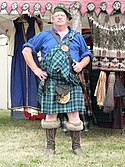Belted Plaid
Der Belted Plaid stellt die Vorform des schottischen Kilts dar. Erste Erwähnungen findet der Belted Plaid Ende des 16. Jahrhunderts. Der Belted Plaid wurde ausschließlich von Männern getragen.[1]
Der Belted Plaid besteht aus einer ca. eineinhalb Meter breiten, vier bis sechs Meter langen Stoffbahn, die beim Anlegen gefaltet und um den Körper „gelegt“ wird. Dabei bleibt eine lange Bahn übrig, die als eine Art Schärpe über die Schulter gelegt werden kann. Der Kilt wird mittels Gürtel und einer Fibel für die Schärpe fixiert. Die Schärpe kann „aufgefächert“ werden und dient dann als Mantel, bzw. Umhang.[2]
Das Anlegen eines Belted Plaids ist relativ kompliziert und bedarf einiger Übung, damit das Kleidungsstück gut sitzt und nicht bei jeder Bewegung verrutscht.
Siehe auch
Weblinks
- How To Put On a Kilt – How To Wear A Kilt. youtube.com; abgerufen am 26. November 2014.
Einzelnachweise
- ↑ www.macroy.de
- ↑ Brief History of the Kilt - The Scottish Tartans Museum and Heritage Center, Inc. Abgerufen am 19. Januar 2022.
Auf dieser Seite verwendete Medien
Scottish mercenaries, assumed to be men of Mackay's Regiment landing in the Baltic port of Stettin (Szczecin) in 1630 or 1631. This print is regarded as the earliest surviving depiction of Highland dress. The original caption states, "They are a strong and hardy people who survive on little food. If they have no bread, they eat roots [turnips may be intended]. When necessary, they can cover more than 20 German miles in a day's forced march. [1 German mile = 4¾ English miles!] Besides muskets, they carry bows, quivers and long swords."
Autor/Urheber: © James F. Perry, Lizenz: CC BY-SA 3.0
In this front view, one of the merchandise vendors at the 2007 Skagit Valley Highland Games models a modern example of the belted plaid. The belted plaid was the forerunner of the modern kilt and was common in the Highlands of Scotland from the late 16th century until the mid 17th century. The plaid in the photograph shows the modern-day Lamont pattern. In historical times, the patterns in use were varied and depended on the local weaver. Clan tartan patterns did not come into existence until much later. See Image:Belted_plaid_07SV_402.jpg for a rear view.
Autor/Urheber: © James F. Perry, Lizenz: CC BY-SA 3.0
In this rear view, one of the merchandise vendors at the 2007 Skagit Valley Highland Games is shown wearing a modern example of the belted plaid. The belted plaid was the forerunner of the modern kilt and was common in the Highlands of Scotland from the late 16th century until the mid 17th century. The plaid in the photograph shows the modern-day Lamont pattern. In historical times, the patterns in use were varied and depended on the local weaver. Clan tartan patterns did not come into existence until much later. See Image:Belted_plaid_07SV_401.jpg for a front view.





